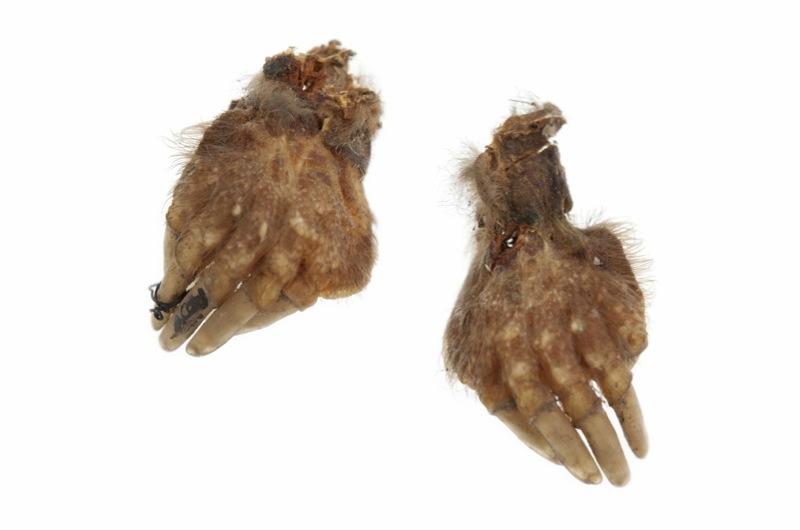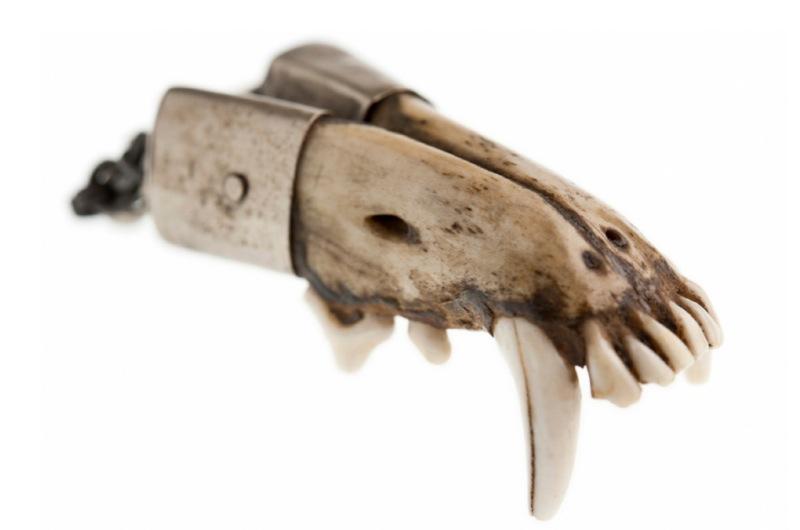London’s Wellcome Collection has a fascinating collection of charms and amulets on display. The amulets were collected by amateur folklorist Edward Lovett (1852–1943) who had a particular interest in superstitions. Over the years he accumulated 1,400 beautiful, odd, creepy pieces which he first displayed in an exhibition at the Wellcome Historical Medical Museum in 1916. Most of the collection belongs to Oxford University’s Pitt Rivers Museum now but has been loaned to the Wellcome again almost a hundred years later.
Lovett was a cashier at a London bank who lived in Croydon. His real passion, though, was collecting objects people carried for good luck. He would roam the East End slums and docks of London at night looking for interesting specimens to buy off of sailors and hawkers. Because people came from all over the world to London’s docks, he ended up amassing an enormous quantity and variety of charms, so many that his wife walked out on him in 1925.
He wrote a book that year, Magic in Modern London, about his research and collection. He wasn’t an assiduous labeler, I’m afraid, so many of the 1,400 objects have no information about their context — where he got them, from whom, what their magical properties were — which makes the descriptions in the book invaluable.
There’s a selection of some of the most intriguing pieces in the Wellcome’s online gallery, along with some quotes from Magic in Modern London. I was surprised at how few of the charms I recognized as superstitions I’ve personally encountered (or engaged in). Red coral, the number 13, horseshoes, rice at weddings and wishbones are the only ones in the gallery I’m familiar with, and they’re not even the most interesting ones.
How would you like to carry two mole’s feet to keep you safe from the agony of cramps?

“The front feet of a mole are permanently curved for digging, and this curved appearance is so suggestive of cramp that these feet are carried as a cure for cramp.” Edward Lovett, Magic in Modern London, p. 78
Perhaps the lower jaw of an indeterminate small critter with a silver-mounted chain instead?

My favorite, though, looks fresh from the set of Nine Inch Nails’ “Closer” video (NSFW):

“A cow keeper, who was one of the old school and originally came from Devonshire, had the misfortune to incur the intense wrath of a man of vindictive temper. He threatened to bewitch the poor man’s cows, and two of then died. The cow keeper there upon, took the heart of one of the dead animals, stuck it all over with pins and nails and hung it up in the Chimney of his house… such action is supposed to be of such a serious nature that it brought about an arrangement of a more or less satisfactory character.” Edward Lovett, Magic in Modern London, p. 67
I’m impressed by how individual these practices were. Lovett said in his book that many times the owners of the talismans would assure him they weren’t superstitious at all; it’s just that x object genuinely saved their lives this one time. Lovett wasn’t the best at cataloging and documentation, but he was able to collect arresting physical representations of the immense variety of beliefs. His contemporaries recognized that he was doing something special, even new, by studying contemporary folklore.
I see that this is one of the new wave of museum exhibits, curated by an artist who has an “engagement with the collection”. Sometimes it works brilliantly, sometimes it is merely annoying. This one, however, looks pretty damned good and the Wellcome Museum seems a perfect context. For quite a few years, I lived on Museum Road in Oxford–in the shadow of the Pitt Rivers Museum–and who knew? I never suspected that the Lovett Collection lurked inside. You seem to be on quite a roll for Halloween! So, how about the Museo della Specola here in Florence?!
I’ve never been, but I just looked it up online and their collection of wax anatomical figures looks phenomenal.
Certainly, the lucky charm you have for the History Blog is working well. Is it a USB stick full of future posts?
I wish! Here’s hoping that mole foot I’ve been carrying around will turn into a post-laden thumb drive.
Awesome. Now I must get and read Lovett’s book!
I was bummed that it wasn’t available on Google Books already. Good thing you have access to a huge library. (library!)
Absolutely fascinating. One of my fave finds of yours, liv, even with all the icky. This is definitely rabbit holing material.
Thank you, although I’d say the icky is a large part of the fascinating.
Wow, those were really strange and interesting. It reminds me a little of the witch bottles and witch cakes of New England, which were used to protect people from curses.
I thought of the witch bottles too. (Here’s a great story about a 17th century one found in the UK.)
I love your blog. I’m come from a long line of Connecticut Yankees myself. 🙂
Obviously she was a witch or an evil spirit then. Pity there isn’t any way of determining which charm or charms were responsible for driving the fiend away.
😆
Thanks for the link. Great article. Its funny that most of the witch protection recipes call for urine. Sometimes you had to eat it to make it work too, which seems pretty awful. Thanks for checking out my blog too. You have tons of great info on yours. I’m definitely gonna keep reading.
It ain’t easy keeping the evil spirits at bay, that much is clear. So much urine to drink…
I went to to see “Charmed Life” today at the Wellcome. I too collect Amulets and as you might guess, loved this exhibition – personally, i might not have wanted some of Lovetts charms in my collection, but for all that I found it engaging and whimsical….well worth a visit.
I am living vicariously through you. What did you think of how Felicity Powell’s art integrated into the exhibit?
I was bummed that it wasn’t available on Google Books already.
If it was published in 1925, then it won’t be public domain in the U.S. until 2021. The only works in the public domain in the U.S. are those published before January 1, 1923, books released into the public domain upon publication (e.g. most government reports), and those for which copyright expired without being renewed (mainly pulp novels and magazines).
God thing he wasn’t trying to collect a whole set!